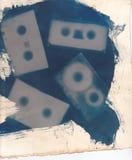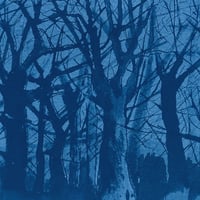blue forty-nine: Staraya Derevnya
It weaves like a sidewinder and it ticks like clocks. The largely improvised sound conjured by the fluid group of humans that is Staraya Derevnya is an elusive, enigmatic thing.
It feels unforced and organic, familiar and old. It feels like it’s crawling from the earth with a mission in mind, muttering spells at the night.
Some admirers have framed this bewitching noise as a type of krautrock or psychedelia, but neither of these feel right – I don’t sense hedonism or abandonment in these very deliberate if often abstract arrangements.
Staraya Derevnya began as a teenage rock band back in 1994 and has existed in a state of fluidity between Israel and the UK since 2010. The collective identified a new musical language of their own with the release of 2016’s Kadita Sessions set of improvisations and have restlessly pursued That Sound since then, thanks to the hands and minds of a revolving cast of musical and non-musical members.
“Our lineup is very fluid and changed many times over the years,” says Gosha Hniu, the group’s de-facto editor. “People don't necessarily have defined roles or instruments. Or might not even play music but do fine art or animation instead.”
“In the concert mode there are currently six members and everyone is free to move the gig in any direction, so I would say it is a democracy.”
Although it doesn’t immediately sound like a live recording – Gosha’s attentive mix being so immersive and full of space and detail, and unlike the claustrophobia and murk of so many live improv recordings – blue forty-nine was recorded live as part of a multimedia set at London’s home of experimental music, Café OTO.
“I don't like the idea of recreating studio recordings in live settings,” reasons Gosha. “If you try to imitate something with limited means it would always sound worse than the original. Instead, we try to strip as much as we can from the songs, leaving only the basic ingredients, for example a bass line and some of the lyrics. Everything else would be re-imagined during the concert.”
What emerges are remarkably restrained, prowling poems made out of words imagined and real and a chamber orchestra of sounds plucked, blown and bowed.
This is a deeply evocative set that will appeal to fans of Blue Tapes artists such as Minaru, Richard Youngs and Stuart Chalmers/Taming Power.
Praise for Staraya Derevnya
“It’s deceptive. Often sounding rudimentary in its use of wheel lyre, flute, double bass, and kazoo. The sounds click and clack together. Yet there are cleverly integrated effects in its midst. Noises manipulated and reversed. Synthesizers twittering and burbling. Theremins surging. All deftly slotting together to create a psychedelically bucolic headspace. Like tramping around the woods with a gut full of psilocybin, picking up on every strange sound, from a twig snap to an un-oiled gate. Rustled leaves, whipped wind, scattered rain, and your own pensive heartbeat, Staraya Derevnya manifest it all. Almost as if it has been hewn from the land and fed directly into the players’ frontal cortices.” – The Quietus
“Due to the nature of the collective hailing from across the globe, the group’s performances both live and recorded feel like chance moments in time.” – Louder Than War
“For those wishing to experience more than the verse chorus verse template, look no further.” – The Sleeping Shaman
“…a myriad of styles, crossing between folk and avant-garde elements that go as far as krautrock, and ethereal sounds that progress in an almost endless experimentation process.” – Densidad
“Sounds like Comus and Faust fighting over a rare cache of Japanese psychedelic rock. An unnerving, brilliant album.” – Folk Radio
“…primordial squigglings over an ever-reliably-chugging bassline and builds upon a repeated phrase dervishly swirling and repeating and building and repeating and building and swirling. The piece doesn’t so much resolve as exhaust itself in experimental ecstasy.” – Holiday At The Sea


